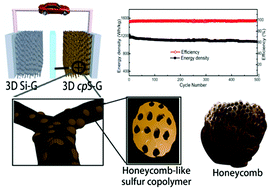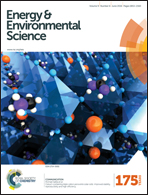A new configured lithiated silicon–sulfur battery built on 3D graphene with superior electrochemical performances†
Abstract
Although lithium–sulfur batteries are one of the most promising energy storage devices with broad applications, they are hampered by the poor cycling problems associated with both the sulfur cathode and the lithium-metal anode. Herein, we develop a newly configured lithiated silicon–sulfur battery by using a honeycomb-like sulfur copolymer on 3D graphene (3D cpS-G) as the cathode and a 3D lithiated Si-G network as the anode. In the case of 3D cpS-G, the honeycomb-like sulfur copolymer are uniformly distributed on three-dimensional graphene networks. Such a unique cathode not only facilitates the fast diffusions of electron and lithium, but can also efficiently inhibit the dissolution of polysulfides and accommodate the large volume change of the sulfur copolymer during cycling processes. When assembled as half cells, the 3D cpS-G exhibits excellent electrochemical performance. More attractive is that when coupled with the 3D lithiated Si-G anode, the full Si–S cell exhibits superior electrochemical performances in term of a high reversible capacity of 620 mA h g−1, an ultrahigh energy density of 1147 W h kg−1 (based on the total mass of the cathode and the anode), good high-rate capability and excellent cycle performance over 500 cycles (0.028% capacity loss per cycle).


 Please wait while we load your content...
Please wait while we load your content...